Greetings
The actinide series consists of 15 elements, starting from actinium, and is of interest not only as nuclear fuel materials but also as elements exhibiting unique chemical/physical properties. Actinium, which had been considered as one of the most useless element, made a name for itself as a nuclear medicine in 2016 when it has been proven to have the ability to cure metastatic cancer. With the exception of uranium, the actinide series element has only been discovered a little more than 90 years ago and their properties has generally not been well known.
Our researches are conducted in collaboration with researchers in many fields including physics, chemistry, pharmacology, and medicine. Our institute Is located in the southernpart of Osaka Prefecture and has an extensive campus with hot labs, KUR and various accelerators. Our laboratory collaborates with the Department of Nuclear Engineering, Graduate School of Engineering, Kyoto University.
Laboratory
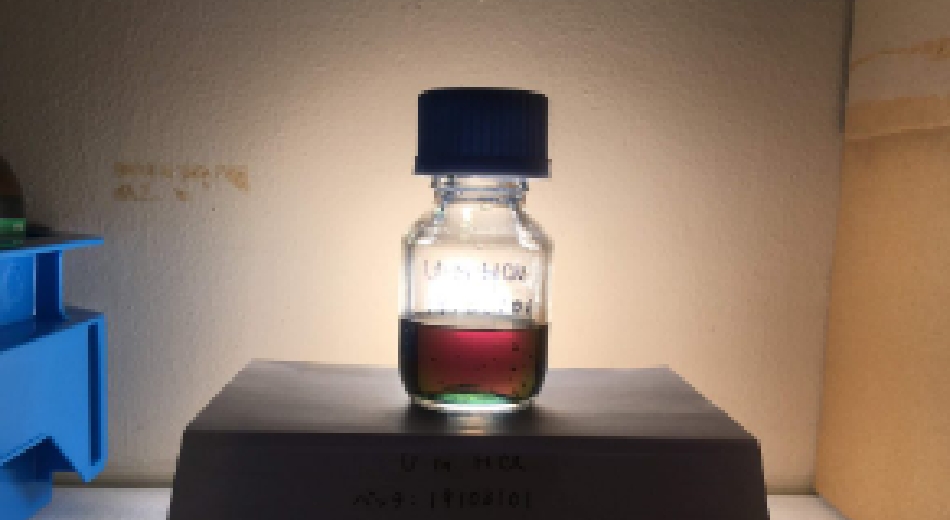
Trivalent uranium that gives a beautiful burgundy colorPhoto by C.Tabata
A field with a long history of actinide chemistry
Our division was established in 1963 as the “Division of Management of Hot Laboratory Facility”. It has played an leading role in actinide chemistry.
In FY2018, the division was renamed as Condensed-matter Chemistry in Actinides(CCA), aiming at the new development of actinide science through the fusion of chemistry and physics and the contribution to nuclear chemistry, fuel cycle, and decommissioning.

Beautiful yellow uranium hexa-valent β-diketone complexPhoto by C.Tabata
What is Condensed-matter Chemistry in Actinides?
The actinide elements heavier than uranium have been generated only 90 years ago and scientific reseaches has proved to possesses intriguing properties such as coexistence of ferromagnetism/superconductivity, very fast electrode reactions, etc. Our laboratory aims to develop new materials for actinide compounds and to elucidate their physical and chemical properties from the microscopic electronic level.
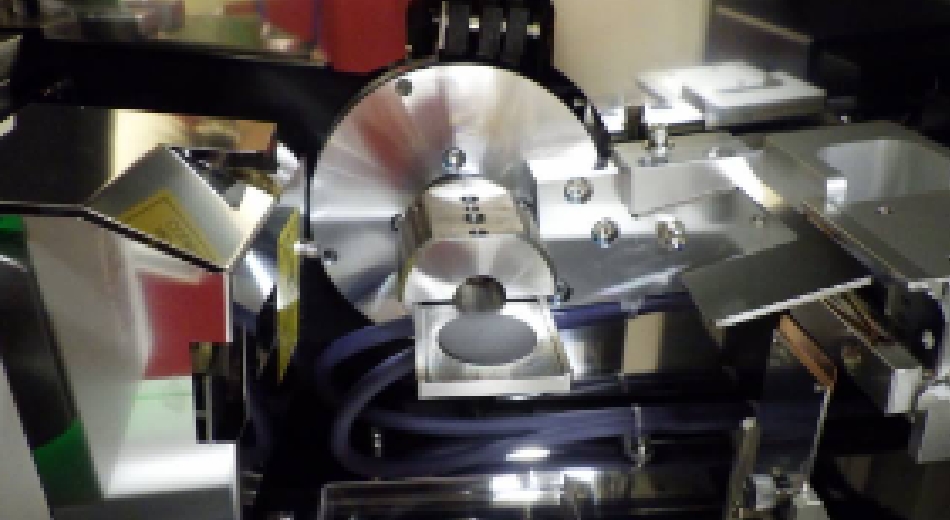
Powder X-ray diffractometer (XRD) goniometerPhoto by C.Tabata
Apply the knowledge you learn.
Apply your knowledge of actinide physical chemistry to solve global problems in a wide range of fields, including inorganic chemistry, nuclear energy (nuclear fuel cycle, radioactive waste), nuclear medicine, and batteries.
Overview on Condensed-matter
Chemistry in Actinides
 ZOOM
ZOOM
Basic and applied research on actinides in terms of nuclear and electronic properties - Research on preparation/examination/
utilization
Research
Condensed-matter
Chemistry in Actinides
Elements heavier than uranium have been discovered only 90 years ago and, thereafter, treated as a nuisance as “radioactive waste”. However, the actinide elements have exhibiting some intriguing properties, such as superconductivity, magnetism, chemical reactions, and electrode reactions.
Addressing Radioactive Waste
Nuclear power is an essential energy source for a country with few natural resources like Japan. However, its byproduct of radioactive waste is a major problem for us, a country with a small land area. Most of the radioactive waste with very long halflife are minor actinides, actinide element of americium, curium and neptunium. Our research activities in actinide chemistry could contribute to mitigation of the problem.
Medical RI Manufacturing
The article published in 2016, in which a patient with cancer metastasized throughout the body was completely cured by administration of RI(Ac-225). The supply of medical RIs is important for the realization of nuclear medicine therapy, but the amount of RIs produced in Japan is still not enough. We are conducting research for the production of medical RIs by using nuclear reactors or by milking nuclear fuel materials.
Batteries capable of high-
power charging and discharging
Renewable energy sources are also essential for future energy. Our researches in condensed-mater chemistry of actinide have been applied to batteries with very fast electrode reactions, such as uranium-redox flow batteries and neptunium-redox flow batteries. Based on this experience, we are now conducting research on vanadium semi-solid-state batteries with the world’s highest output power.
3-base platform
National Joint-Use Facilities in the Actinide Field
All elements in actinide series are radioactive. Most of the nuclides need to be strictly controlled as alpha-emitters. In ddition, uranium, thorium, and plutonium must be metrologically controlled as nuclear fuel materials. Therefore, only three university facilities in Japan are capable of cooperative researches using actinide elements. We are working together to ensure experimental researches at the most appropriate location and under the most appropriate techniques.
- Institute for Integrated Radiati on and Nuclear Science, Kyoto University (Hot Laboratory)
-

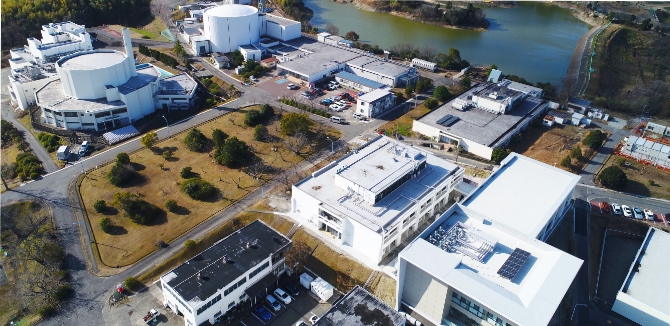
- Institute for Materials Research, Tohoku University
-
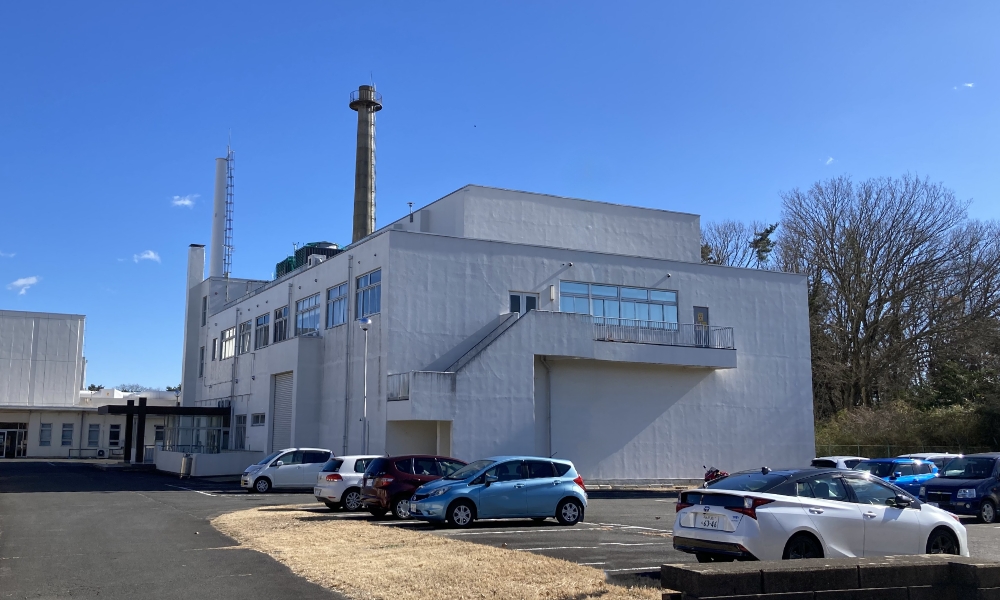
International Research Center for Nuclear Materials Science (Oarai Center, Actinide Elements Experimental Building)
- Institute for Materials Research, Tohoku University
-
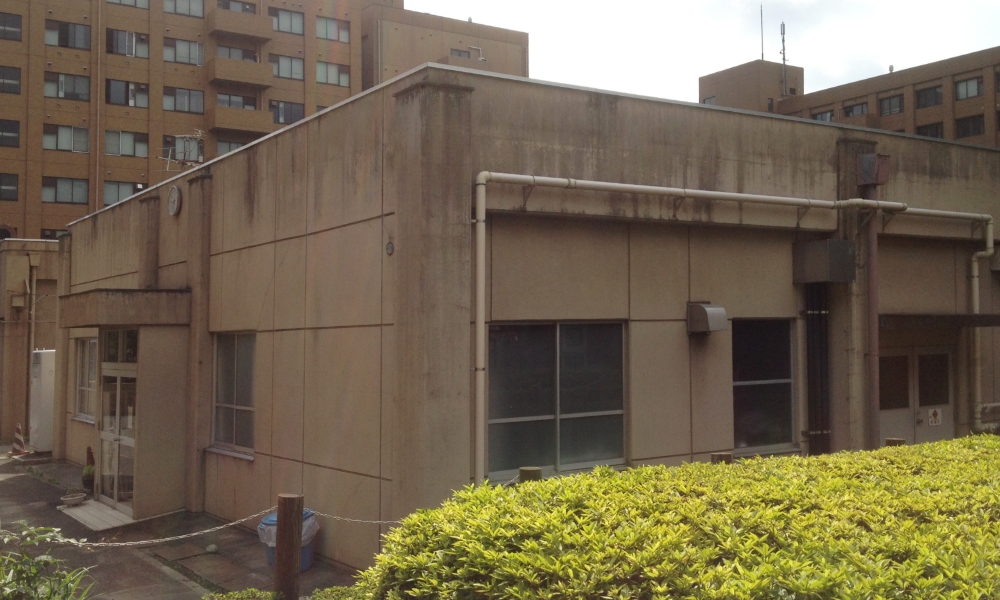
Laboratory of Alpha-Ray Emitters (Sendai)
History of our topical meeting on actinides
- Fiscal Year, Conference Name(Classification), Place
- 2008-2009, Actinide Elements Lab. User’s Meeting (IMR, Oarai meeting, Tohoku Univ.), Oarai
- 2008-2009, Scientific Meeting of Grant-in-Aid for Scientific Research(S) developed in Lab. of ARE (Tohoku Univ.), Sendai
- 2010, Oarai User’s Meeting including Lab. of ARE (Tohoku Univ.), Sendai
- 2011-2014*, Joint meeting User’s Meeting of Lab. of ARE (Tohoku Univ.) with Grant-in-Aid for Scientific Research(S) meeting, Sendai (*exclude 2012; Meeting was not held due to the Great East Japan Earthquake)
- 2015-2016, User’s meeting of Lab. of ARE ( Tohoku Univ.), SendaI
- 2017, Collaboration of Workshop ‘Science and Technology of Actinide Elements’(IMR Workshop, Tohoku Univ.), Sendai
- 2017, Actinides-2017 (International Conference held every 4 years), Sendai
- 2018-2021, Topical meeting on Condensed-matter Chemistry on Actinides (PartlyInstitute’s official conference), Kumatori
- 2022-2023, Users meeting on ‘Condensed-matter Chemistry in Actinides and their Applications / Production of medical RIs by Reactor Irradiation’ (Institute’s official conference), Kumatori
Actinides
The Institute’s predecessor, the Research Reactor Institute, was established in 1963 at the dawn of nuclear energy as an affiliated research institute of Kyoto University. Since then, it has safely operated and managed university research reactors and served as a national joint-use facility, and in 2018, it was renamed and reorganized as the Institute for Integrated Radiation and Nuclear Science (hereafter abbreviated as “KURNS”), which aiming at “Composite Nuclear Science,” a technology and science that uses nuclear and radioactive materials as nuclear energy in a broad sense.
The planned shutdown of KUR in FY2026 and the new experimental research reactor (to be constructed in Fukui Prefecture), will be major events for the institute. Our institute has progressed in several fields such as the establishment of the “Frontier Center” in April 2023, the renovation and the construction of research buildings in FY2023, and starting service of rental laboratory in FY2024. The Institute will undergo a major transformation in the future, and discussions are underway on what kind of institute it will become.
Among the roles that KURNS will play in actinide researchs, the improvement in the research environment is considered important for nuclear power and medicine. We would like to make efforts to collaborate with related parties and improve the environment.
March 2024 Tomoo Yamamura
Contact
We welcome questions concerning our researches.
If you are a student who would like to join our lab or a researcher who would like to visit our lab, please feel free to contact us.
